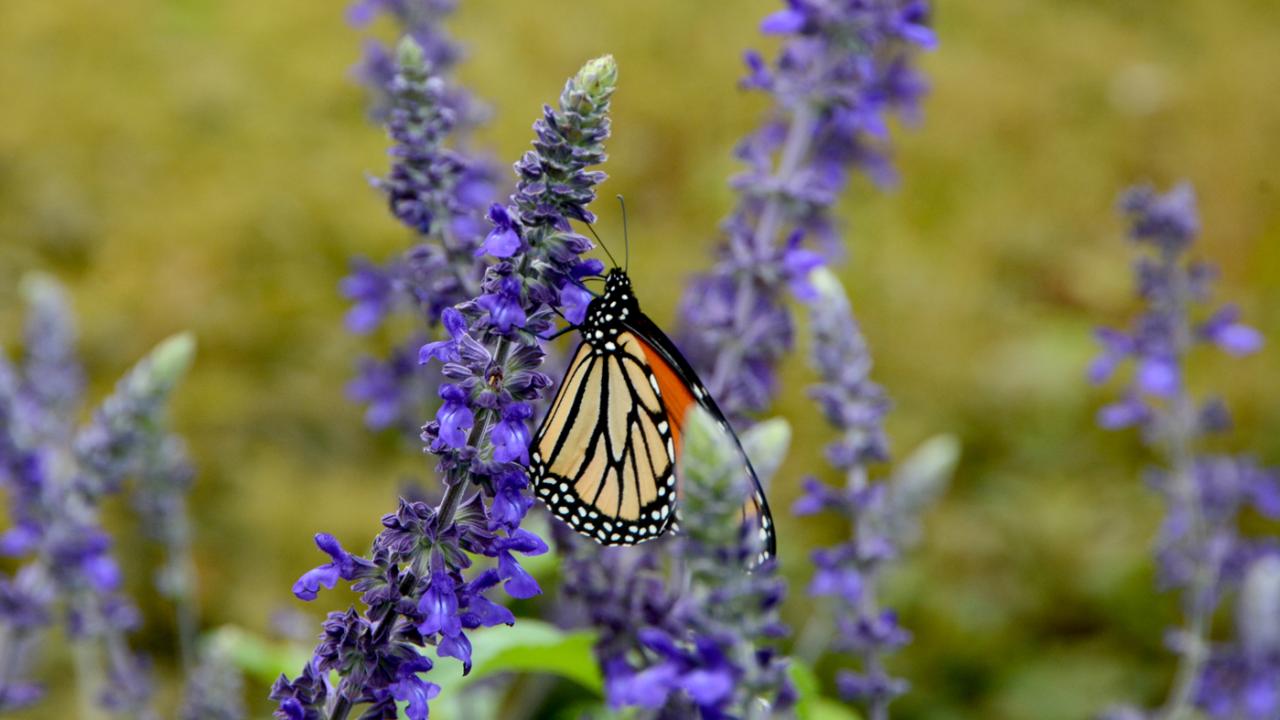

An Evaluation Study of Tender Salvias (Salvia spp.)
An Evaluation Study of Tender Salvias
(Salvia spp.) | Issue 44 2019
Richard G. Hawke, Plant Evaluation Manager and Associate Scientist
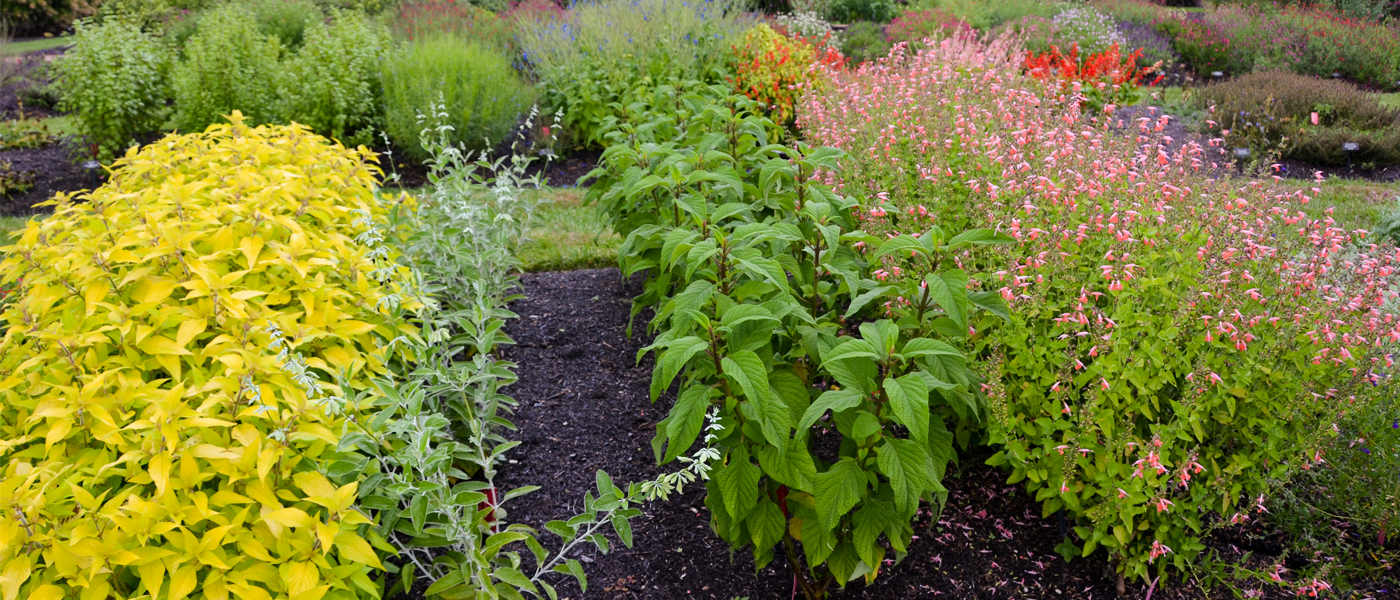
Salvia trial beds in the Lavin Plant Evaluation Garden
In the Upper Midwest and other temperate regions, woodland sage (Salvia nemorosa, S. xsylvestris) and meadow sage (S. pratensis) are familiar and dependable hardy perennials. Appreciated for the richness of their sapphire- and amethyst-colored flowers, these salvias put on their big show in late spring and early summer. While both beautiful and beneficial— early pollinators are frequent visitors— hardy salvias are in their prime for a relatively short period of the growing season. Extending the season is possible with tender salvias—a remarkably diverse group of non-hardy perennials that offer months of rainbow-hued flowers, habits great and small, and leaves in assorted colors, textures, and shapes, each with its own distinctive scent. The free-flowering tender salvias can be used like annuals to boost seasonal color and drama in containers and garden borders, all the while sustaining a host of pollinators from the warm days of early summer to the first frosts of autumn.
Salvia is a large genus with more than 900 species worldwide including annuals, biennials, perennials, herbs, and shrubby plants. Commonly referred to as salvia or sage, they occur naturally in grasslands, woodlands, and mountainous places. The preponderance of tender salvias available to North American gardeners are New World natives of warm regions in Mexico, Brazil, Bolivia, Peru, and the United States. Additionally, hundreds of varieties and hybrids have been bred or selected for cultivation.
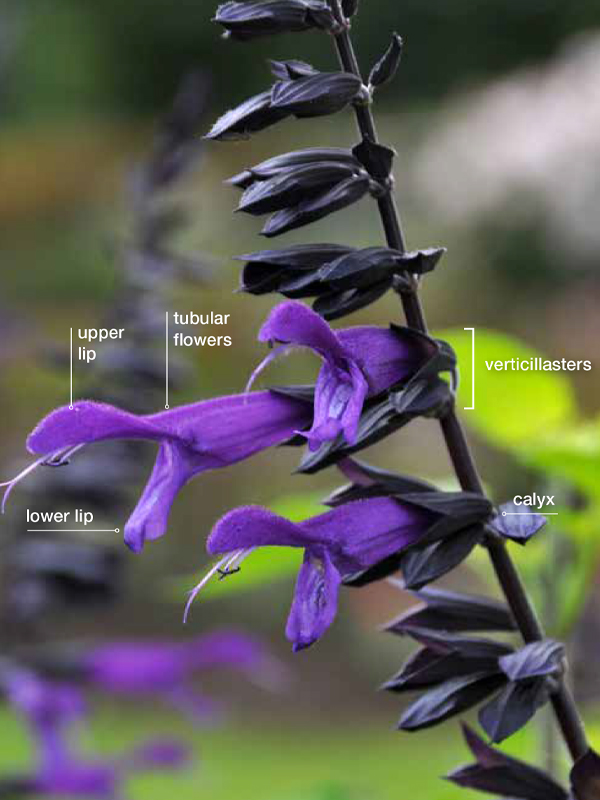
Floral spike of Salvia ‘Amistad’
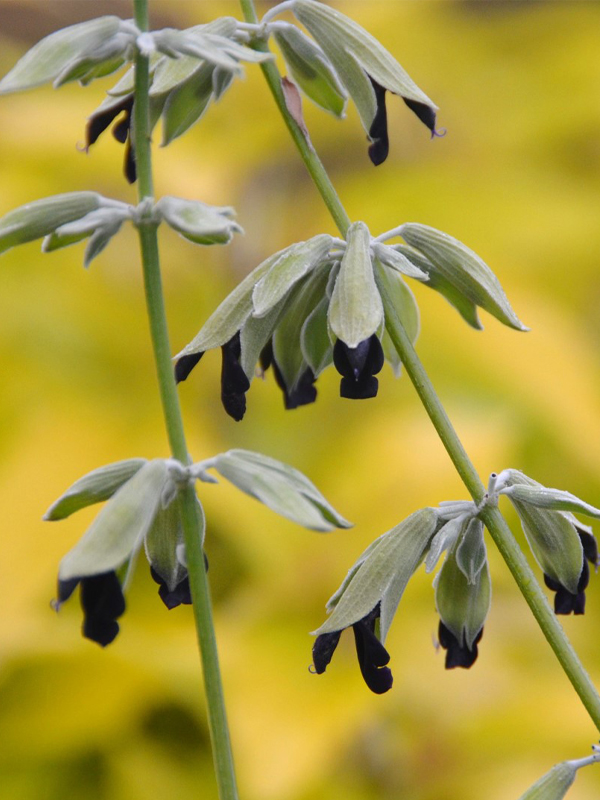
Salvia Discolor
All salvias share common traits like square stems and bilabiate flowers with other members of the mint family (Lamiaceae) such as bee balms (Monarda spp.), betonies (Stachys spp.), and catmints (Nepeta spp.). The tubular flowers feature an upper and a lower lip, although the length of the tube as well as the size and shape of the lips varies by species. Flowers come in many shades of blue, lavender, purple, magenta, pink, red, orange, yellow, and white, or may be bicolored. Each showy flower sits in a colorful two-lipped calyx, which can be an analogous or a contrasting hue to the flower, and typically remains vibrant and persistent after the flowers have fallen away. In some cases, flowers and/or calyces are prominently fuzzy such as Bolivian sage (Salvia oxyphora), Mexican bush sage (S. leucantha), and red velvet sage (S. confertiflora). The flowers are arranged in tiers of whorled clusters or verticillasters on upright to arching spikes, which may be short or quite long, and simple or branched. Each verticillaster consists of several to many flowers that are either tightly crowded or more openly held on the spike. The spacing of the verticillasters influences the impact of the floral display.
Like the flowers, the leaves of tender salvias are variable in size, shape, color, texture, and fragrance. The leaves sit oppositely on square stems and range from green to gray, large to small, lustrous to fuzzy, heartshaped to needlelike, and may be sticky as are Salvia discolor and S. microphylla var. neurepia. Each species has its own particular scent—from fruity to medicinal to rank-smelling. Pineapple-scented S. elegans and lightly bubblegum-scented S. discolor are sweetly fragrant; whereas S. puberula and S. confertiflora are slightly malodorous. Some salvias exhibit a distinctive color contrast between the two sides of the leaves; for example, S. discolor has green leaves with densely white hairy undersides, and S. confertiflora features dark green leaves with undersides covered in rusty hairs. Many tender salvias have rounded bushy habits, while others are vase-shaped, sprawling, or scrambling, and range in height from under a foot to over 8 feet tall. The size of a salvia in cultivation may differ greatly due to temperature and the length of the growing season; that is, warmer summers and longer autumns result in larger plants.
Salvias are generally undemanding, easy care plants. Most tender salvias prefer full sun and moist, well-drained soils; some species such as Salvia canariensis var. candidissima and S. reptans are drought-resistant once established. Partial to high shade is recommended in hot climates for S. greggii, S. blepharophylla, and S. oxyphora, among others. Some of the newer hybrid cultivars have been developed for greater heat tolerance and increased rebloom. Deadheading to encourage longer flowering is commonly recommended for salvias; cutting back stems by half after the initial bloom pushes a secondary bloom. Monthly fertilizing promotes vigor and larger plant sizes. Salvias can be affected by powdery mildew, rust, stem rot, fungal leaf spot, whiteflies, aphids, and spider mites. The aromatic foliage of most salvias repels deer and rabbits.
In the garden, tender salvias are great substitutes for common summer annuals— providing many months of color and texture as bedding plants, border accents, and most effectively, in seasonal containers. And salvias are ideal for pollinator gardens where they attract a variety of butterflies, bees, and hummingbirds. Many tender salvias start blooming as early as late spring, while others do not show their first flowers until early autumn or later. Exotic late-bloomers such as Salvia regla, S. mexicana, and S. confertiflora are at the whim of the capricious autumnal weather and may not be the best choices for colder regions. Few tender salvias will survive cold temperatures—winter-hardiness varies greatly by species in zones 6b-10.
List of Sections
The Evaluation Study
The Performance Report
Top-rated Tender Salvias
Summary
References
Armitage, A.M. 2008. Herbaceous Perennial Plants, Third Edition. Champaign, IL: Stipes Publishing L.L.C.
Rice, G., editor-in-chief. 2006. American Horticultural Society Encyclopedia of Perennials. New York, NY: DK Publishing, Inc.
Sutton, J. 1999. The Gardener’s Guide to Growing Salvias. Portland, OR: Timber Press Inc.
Whittlesey, J. The Plant Lover’s Guide to Salvias. Portland, OR: Timber Press In..
A special thanks to Alexander Almodovar, Patrick Dahl, and Samantha Danguilan for their assistance in collecting data and photographing the salvias.
-
The Chicago Botanic Garden (USDA Hardiness Zone 5b, AHS Plant Heat-Zone 5) initiated a three-year comparative trial of 109 tender or non-hardy perennial salvias (Salvia spp. and cultivars) in 2016. The goal of the trial was to discover which tender salvias flowered early and were vigorous enough their first year in the garden to make outstanding summer annuals. Stock plants were acquired in 2015 and cuttings were taken in winter for use the following springs. All plants were the same size and age when planted each spring from 4-inch pots. After the initial planting in June 2016, the trial was replanted in June of 2017 and 2018.
Five plants of each taxon were grown in side-by-side plots for easy comparison of ornamental traits and landscape performance. The evaluation garden was openly exposed to wind in all directions and received at least ten hours of full sun daily during the growing season, which averaged 171 days per year for the 2016-2018 trial period (see Table 1). The clay-loam soil had a pH of 7.4 during this period, and although typically well-drained, the site retained excess moisture for short periods.
Maintenance practices were kept to a minimum, thereby allowing the plants to thrive or fail under natural conditions. Trial beds were irrigated via overhead sprinklers as needed, mulched with composted leaves once each summer, and regularly weeded. Moreover, plants were not deadheaded, fertilized, winter mulched, or chemically treated for insects or diseases. Plants remained in the ground over winter to test cold hardiness, and were removed in the spring after assessing survival.
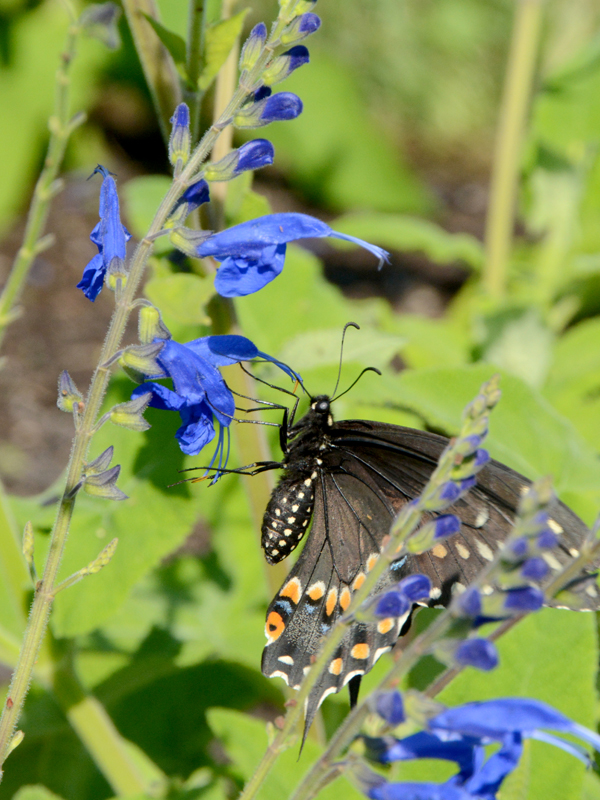
Salvia sagittata
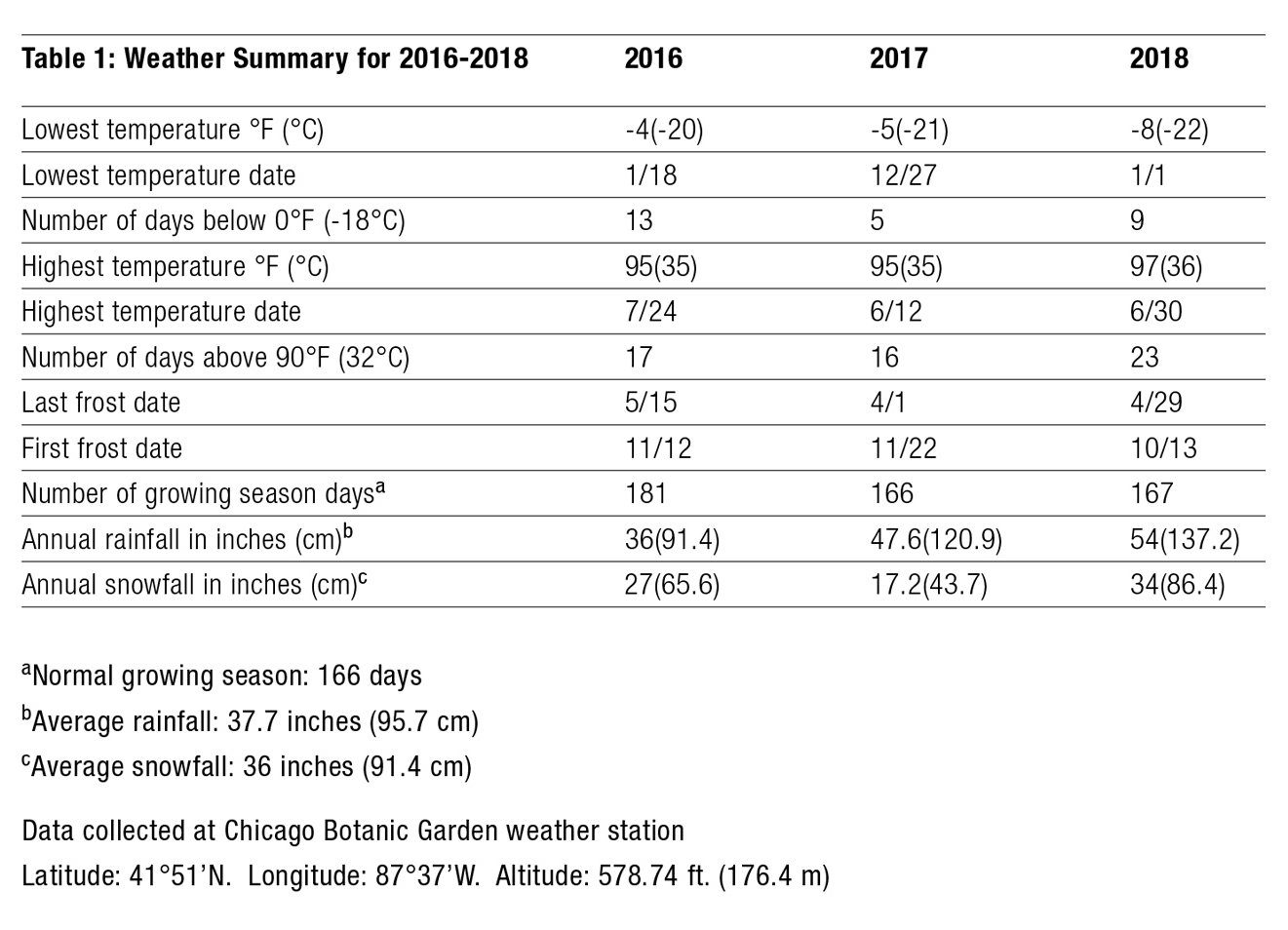
The Chicago Botanic Garden (USDA Hardiness Zone 5b, AHS Plant Heat-Zone 5) initiated a three-year comparative trial of 109 tender or non-hardy perennial salvias (Salvia spp. and cultivars) in 2016. The goal of the trial was to discover which tender salvias flowered early and were vigorous enough their first year in the garden to make outstanding summer annuals. Stock plants were acquired in 2015 and cuttings were taken in winter for use the following springs. All plants were the same size and age when planted each spring from 4-inch pots. After the initial planting in June 2016, the trial was replanted in June of 2017 and 2018.
Five plants of each taxon were grown in side-by-side plots for easy comparison of ornamental traits and landscape performance. The evaluation garden was openly exposed to wind in all directions and received at least ten hours of full sun daily during the growing season, which averaged 171 days per year for the 2016-2018 trial period (see Table 1). The clay-loam soil had a pH of 7.4 during this period, and although typically well-drained, the site retained excess moisture for short periods.
Maintenance practices were kept to a minimum, thereby allowing the plants to thrive or fail under natural conditions. Trial beds were irrigated via overhead sprinklers as needed, mulched with composted leaves once each summer, and regularly weeded. Moreover, plants were not deadheaded, fertilized, winter mulched, or chemically treated for insects or diseases. Plants remained in the ground over winter to test cold hardiness, and were removed in the spring after assessing survival.

Salvia sagittata

-
In early June of 2016, 2017, and 2018, the salvias were planted in the full-sun trial garden, and evaluated for their cultural adaptability to the soil and environmental conditions of the site; disease and pest problems; and ornamental qualities associated with flowers, foliage, and plant habits. Winter hardiness was assessed but was not factored into the final performance ratings, which are based on flower production and floral display, foliage and habit quality, and plant health and vigor. Table 2 shows the observed plant traits and overall ratings for 107 of the 109 salvias; a numbered selection that was not yet introduced is excluded as is one taxon that was misidentified.

In early June of 2016, 2017, and 2018, the salvias were planted in the full-sun trial garden, and evaluated for their cultural adaptability to the soil and environmental conditions of the site; disease and pest problems; and ornamental qualities associated with flowers, foliage, and plant habits. Winter hardiness was assessed but was not factored into the final performance ratings, which are based on flower production and floral display, foliage and habit quality, and plant health and vigor. Table 2 shows the observed plant traits and overall ratings for 107 of the 109 salvias; a numbered selection that was not yet introduced is excluded as is one taxon that was misidentified.

-
Thirteen salvias received five-star excellent ratings for exceptional flower production over an extended period, healthy foliage, vigorous habits, and adaptability to the growing conditions of the trial garden. Based on cumulative evaluation scores, the top-rated plants in alphabetical order were Salvia ‘Amistad’, S. ‘Balsalmisp’ MYSTIC SPIRES BLUE™, S. coccinea ‘Brenthurst’, S. elegans ‘Golden Delicious’, S. greggii ‘Balmircher’ MIRAGE™ CHERRY RED, S. greggii ‘Balmirhopi’ MIRAGE™ HOT PINK, S. greggii ‘Balmirvio’ MIRAGE™ VIOLET, S. greggii ‘Balmirwite’ MIRAGE™ WHITE, S. greggii ‘Viva’, S. ‘Novasalfuc’ ARCTIC BLAZE® FUCHSIA, S. ‘Novasalred’ ARCTIC BLAZE® RED, S. reptans West Texas form, and S. splendens ‘Dancing Flames’. Additionally, 49 salvias received four-star good ratings for their strong performances.
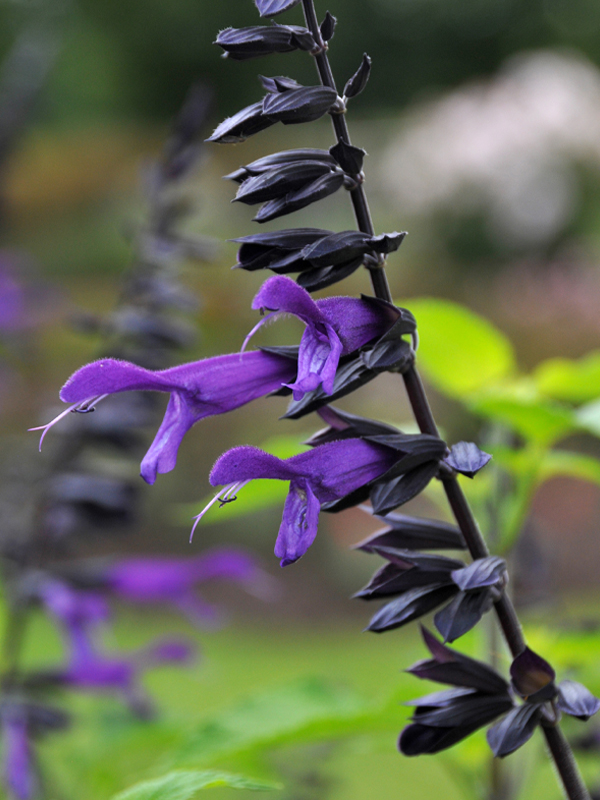
Salvia ‘Amistad’
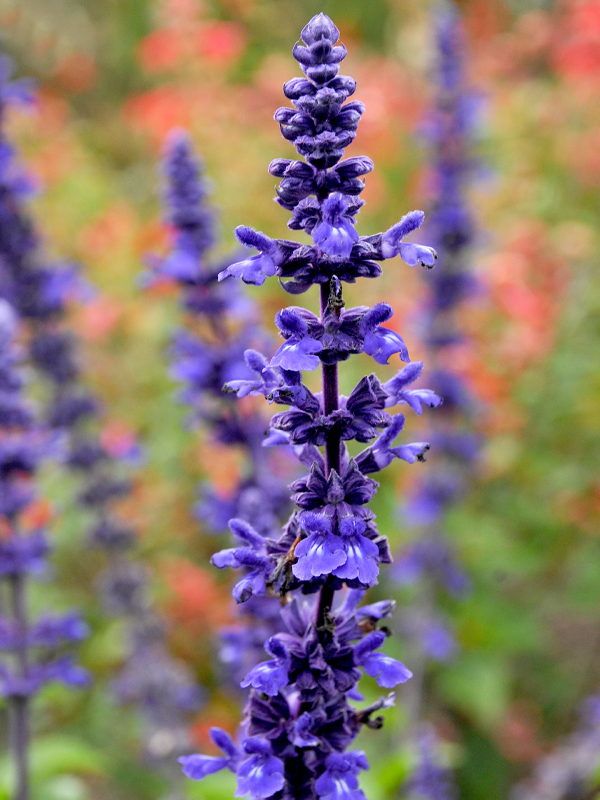
S. ‘Balsalmisp’ MYSTIC SPIRES BLUE™

Salvia coccinea ‘Brenthurst’
Salvia ‘Amistad’ embodied the best qualities of the tender salvias. From mid-June to frost, a bounty of dark purple blossoms nestled in nearly black calyces were loosely borne on erect inflorescences to 11 inches long. The large swarthy flowers were a constant draw for hummingbirds, bees, and butterflies throughout the season. The robust floral show and vigorous habit were impressive each summer despite plants never being fertilized—it was one of the biggest salvias at 46 inches tall and 64 inches wide. ‘Amistad’—meaning friendship in Spanish—originated in Argentina and is thought to be a hybrid between the showy subtropical species S. guaranitica and S. gesneriiflora.
MYSTIC SPIRES BLUE™ (Salvia ‘Balsalmisp’) featured tall spires of purple-blue flowers in violet calyces from late spring to frost. While the individual flowers were small (¾ inch long), the floral show was significant because the verticillasters were densely clustered on long inflorescences—the prolific floral stems made up about half of the plant height. MYSTIC SPIRES BLUE is a compact, well-branched selection of ‘Indigo Spires’ and reached 37 inches tall and 51 inches wide. Planted side by side in the trial, observations in September and October noted that MYSTIC SPIRES BLUE was busy with butterflies and bees while pollinators largely ignored ‘Indigo Spires’. Pollinator visitation during the earlier season was comparable on both cultivars.
The scarlet sage, Salvia coccinea ‘Brenthurst’, was a consistently strong performer with a full robust habit and heavy floriferous nature. Its coral-pink flowers, held in purple- blushed calyces, featured light pink tubes and broad, darker pink lower lips. The bushy mounded habit, to 38 inches tall and wide, was one of the very best in the trial for uniformity. ‘Brenthurst’ was one of a few salvias that reseeded each year; the seedlings were moderately produced and flowered early and true-to-name. Although perennial in Mexico and South America, S. coccinea is recognizable as a widely cultivated and usually red-flowered garden annual.
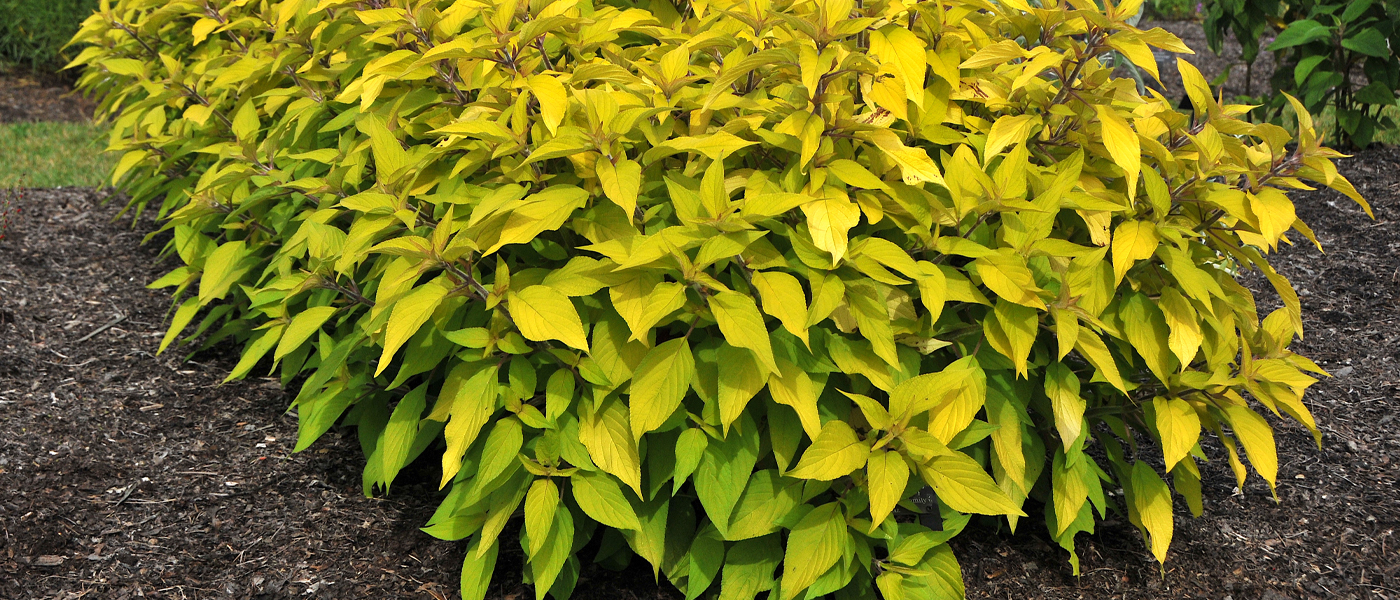
Salvia elegans ‘Golden Delicious’
The sweetly pineapple-scented golden yellow leaves and fiery red flowers of Salvia elegans ‘Golden Delicious’ were a bold combination. The vibrant leaves held their color all summer, although minor sunscald was noted at times during the hottest periods. The robust habit was consistently bushy and broadly mounding to 44 inches tall and 57 inches wide. Plants began blooming in early October, and while flower production was heavy, the full floral display was not observed in any year of the trial. Mid-November frost dates in 2016 and 2017 resulted in an admirable display; however, plants never reached peak bloom. The colorful foliage on its own was significantly ornamental to recommend ‘Golden Delicious’ as a foliage plant for seasonal displays.
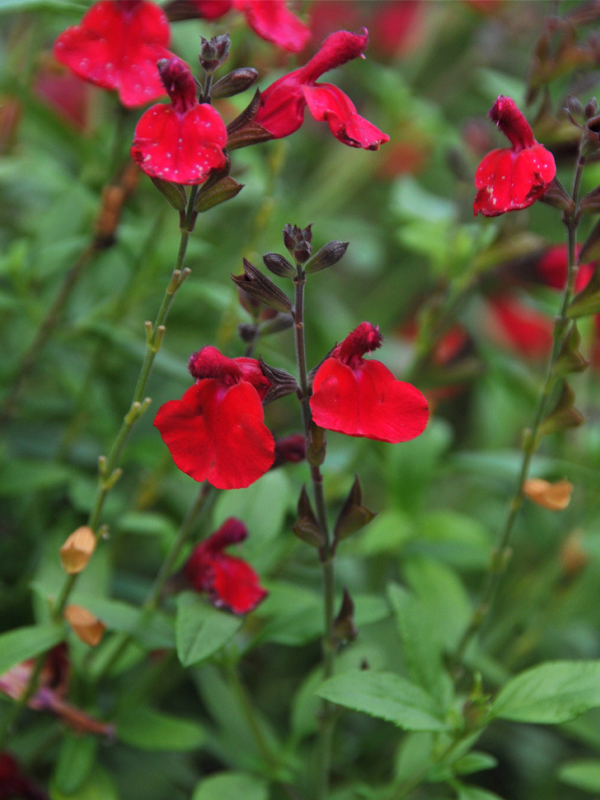
Salvia greggii MIRAGETM CHERRY RED
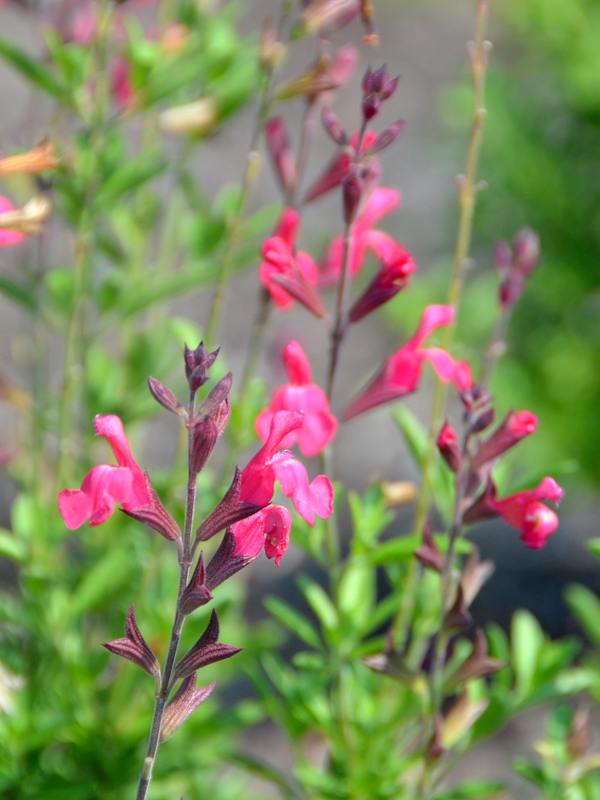
Salvia ARCTIC BLAZE® FUCHSIA
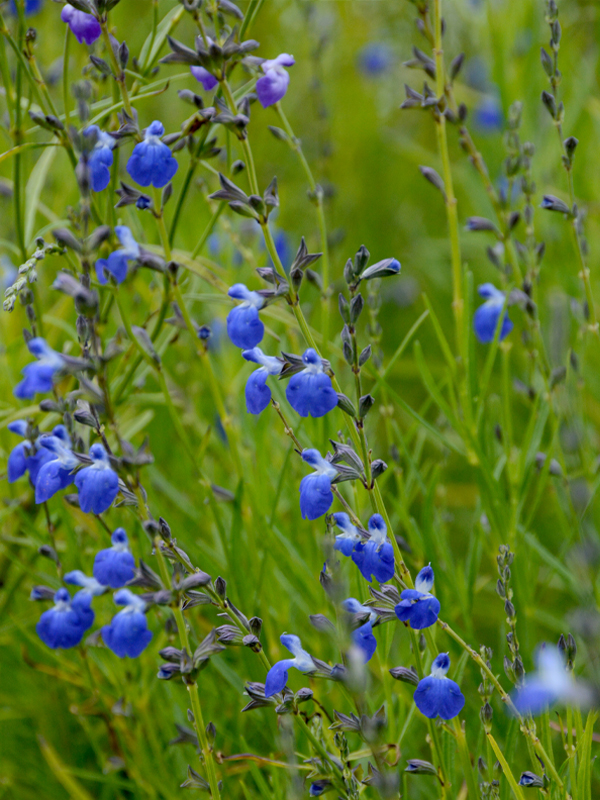
Salvia reptans West Texas form
Salvia greggii, autumn sage, was well-represented in the trial by 27 selections in vibrant shades of red, pink, violet, purple, and creamy white. Five cultivars received the highest ratings for consistently superior habits and exceptionally strong flower production, including ‘Viva’ and four cultivars in the MIRAGE™ series—CHERRY RED, HOT PINK, VIOLET, and WHITE. Nestled in burgundy calyces, the dark magenta flowers of ‘Viva’ were the smallest of the autumn sages at ¾-inch long and opened a couple of weeks later in June than other selections; plants were densely mounded to 26 inches tall and 40 inches wide. CHERRY RED featured dark cherry red flowers and a dense compact habit to 20 inches tall and 30 inches wide. The bright pink flowers of HOT PINK were cupped in green calyces with a purple-red cast; it was slightly larger at 25 inches tall and 36 inches wide. VIOLET featured dark purple calyces and violet flowers on low mounded plants to 19 inches tall and 28 inches wide. The creamy white flowers of WHITE had pale green calyces, and like the other cultivars in the series, produced a well-branched bushy habit to 20 inches tall and 42 inches wide. Loose to irregular habits, and in some cases reduced flower production, were the main reasons why S. greggii cultivars received lower ratings.
ARCTIC BLAZE® FUCHSIA (Salvia ‘Novasalfuc’) and ARCTIC BLAZE® RED (S. ‘Novasalred’) were strong-blooming selections featuring exceptional habit uniformity. The deep reddish pink flowers and purplish calyces of FUCHSIA were plentiful from late June to season’s end. Likewise, the orangey red flowers and purple-red calyces of RED were equally long-blooming. Both selections had compact bushy habits with flexible purplish stems; FUCHSIA was the smallest at 21 inches tall and 26 inches wide and RED was slightly larger at 23 inches tall and 31 inches wide. The habit of ARCTIC BLAZE® PURPLE (S. ‘Novasalpur’) was loose and see-through compared to the others but was similarly floriferous.
The pungent grasslike leaves of Salvia reptans West Texas form set it apart from other salvias in the trial. The fine-textured foliage softened the bushy shrublike plants, which reached a stocky 39 inches tall and wide long before a flower ever appeared. The cobalt blue flowers began opening in early August and bloomed prolifically to frost. At less than ½-inch long, its flowers were the smallest in the trial but the floral display was not diminished by the diminutive size. West Texas form was the only salvia that was truly cold-hardy in Chicago; no crown injury or plant loss occurred in the two winters of the trial.
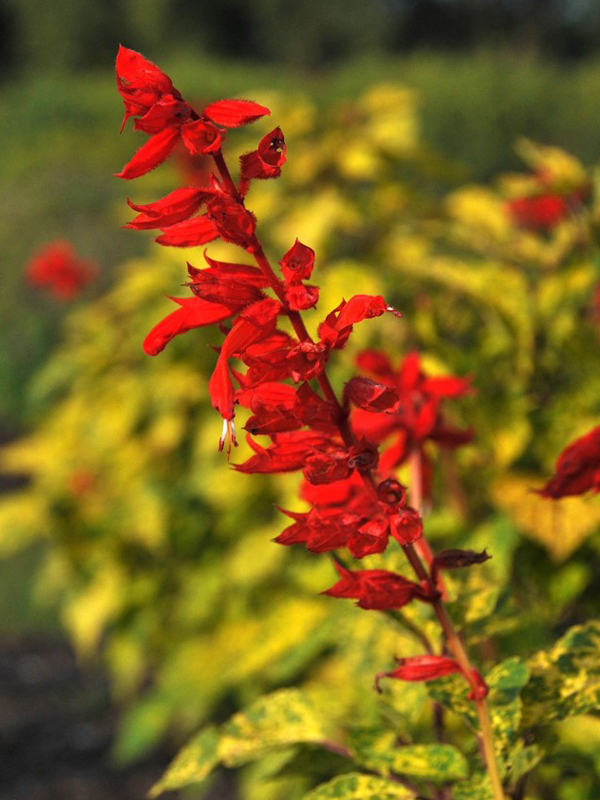
Salvia splendens ‘Dancing Flames’
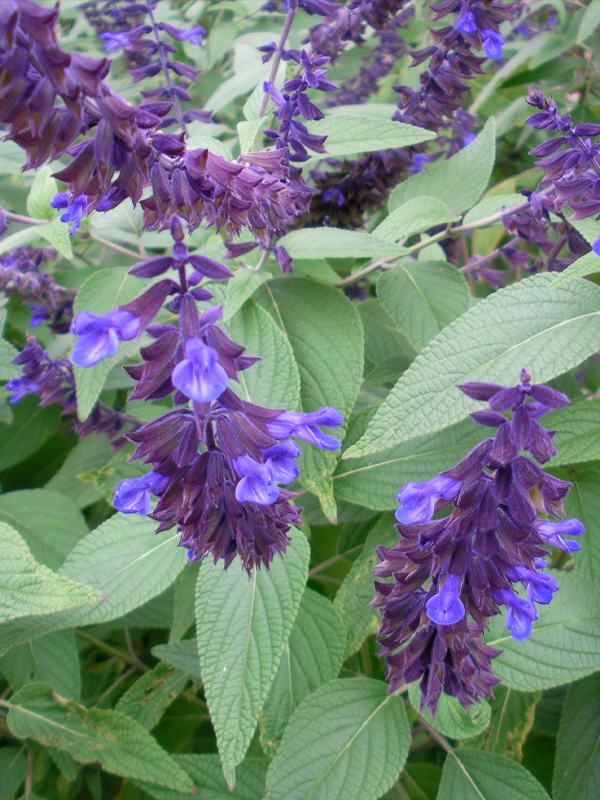
Salvia ‘Anthony Parker’
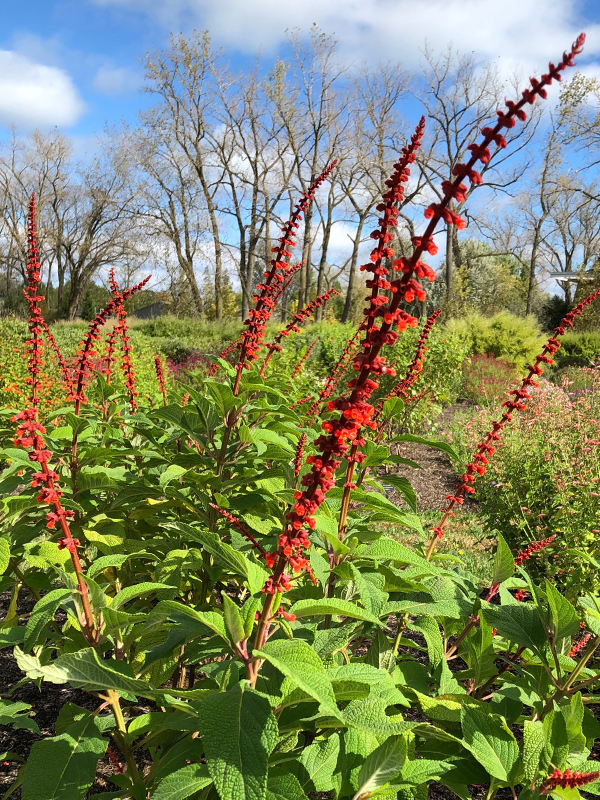
Salvia confertiflora
Salvia splendens ‘Dancing Flames’ featured bright yellow-speckled leaves and large dark orange flowers held in prominent red-orange calyces. The upright bushy habit—31 inches tall and wide—was the best of the splendens-group. ‘Dancing Flames’ started flowering in late June but the overall ornamental display—vibrant flowers, boldly variegated foliage, and red stems—was particularly good in the late season. Salvia splendens is native to Brazil and is a popular bedding plant that comes in a variety of flower colors.
Four additional taxa—Salvia ‘Anthony Parker’, S. confertiflora, S. leucantha ‘Santa Barbara’, and S. mexicana ‘Limelight’—received nearly perfect ratings except that they flowered too late in the season to be considered substitutes for summer-blooming annuals in northern gardens. The abridged bloom period aside, their strong habits, showy foliage, and heavy flower production warrant special mention.
The blue-purple flowers of Salvia ‘Anthony Parker’ were cupped in fuzzy dark purple calyces and held on arching inflorescences to 12 inches long. The flowers opened in late September so were susceptible to frost damage before peak bloom occurred. A strong floral display was observed in 2016 and 2017 before first frost injured the plants on November 12 and November 22, respectively. However, an early frost on October 13, 2018, resulted in a much truncated flower show; in fact, the dark purple calyces rather than any open flowers provided all the color prior to frost. ‘Anthony Parker’ was a dense bushy plant to 50 inches tall and 64 inches wide with attractive foliage similar to S. elegans.
Red velvet sage, Salvia confertiflora, was one of the best-looking plants in all years of the trial. Lush corrugated leaves, dark red stems, and a vase-shaped habit gave it an impressive architectural presence in summer. The vibrant orange-red flowers clasped in fuzzy dark red-orange calyces opened in late September—the small flow ers were crowded together on slender velvety red wands rising 18 inches above the dark green foliage. Flower production was heavy but like other late-blooming selections, the full floral display was not observed due to autumn frosts. The large, textured leaves had rusty undersides and an unpleasant odor when crushed. Red velvet salvia was fast-growing and quickly reached 46 inches tall and 33 inches wide—it grows to 10 feet tall where it is native in Brazil.
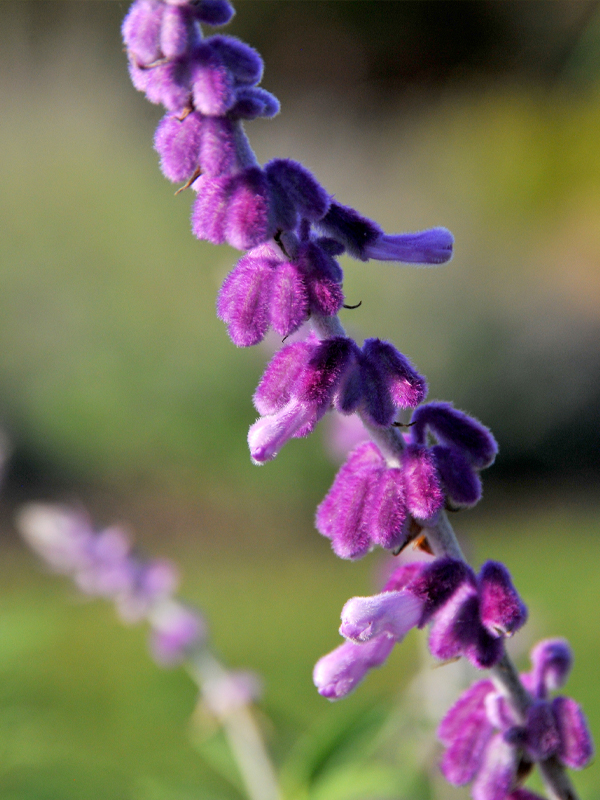
Salvia leucantha ‘Santa Barbara’
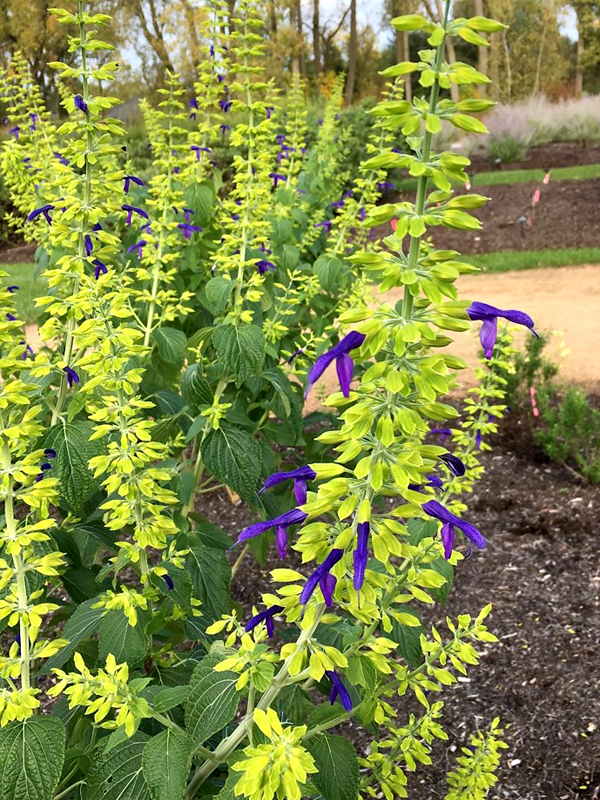
Salvia mexicana ‘Limelight’
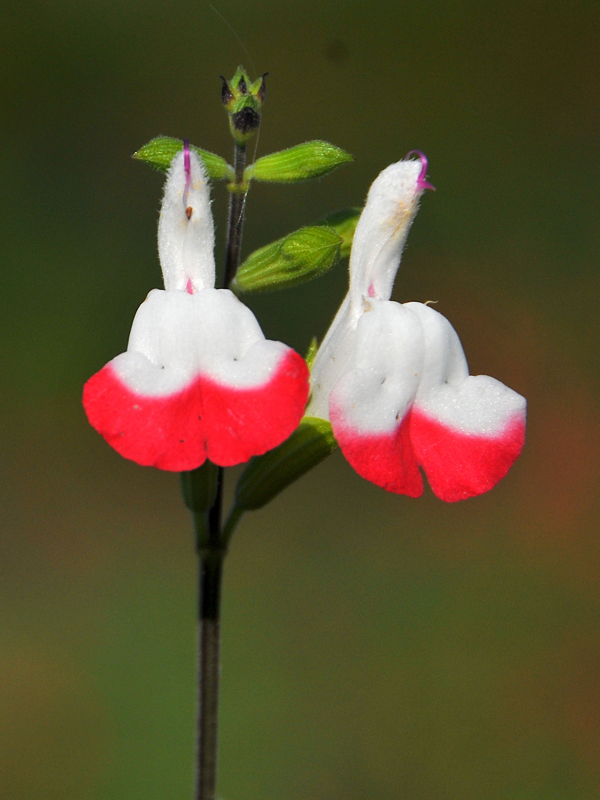
Bicolored Salvia microphylla ‘Hot Lips’
Salvia leucantha ‘Santa Barbara’ was a superior selection because its stems were not as brittle as the species, which constantly suffered snapped branches in strong winds. While the color contrast was not as striking as the bright white and fuzzy purple flowers of the species, ‘Santa Barbara’ produced an exceptionally heavy bloom of light purple flowers with fuzzy dark purple calyces from late September to frost. Despite the late start, 80 percent of flowers were typically open at frost including in 2018. The narrow, downy gray-green leaves were attractive all season, which was an important ornamental feature given the late flowering date; the habit was compact by comparison to the species—nearly 20 inches shorter and narrower.
At 57 inches tall and nearly as wide, Salvia mexicana ‘Limelight’ was one of the largest salvias in the trial. Its glossy heart-shaped leaves and imposing vase-shaped habit were lush and bold-textured all summer. Generous spikes of long dark purple-blue flowers offset by bright chartreuse calyces were the crowning touch. Inflorescences were borne in profusion, but flowers did not open until early October, which mattered a great deal in 2018 when frost came early. In the warmer autumns of 2016 and 2017 when frost was delayed, the floral display was exceptional.
The tender salvias displayed a variety of flower colors in shades of blue, lavender, purple, red, magenta, pink, orange, yellow, and creamy white. Selections with distinctive bicolored flowers included Salvia ‘Autumn Moon’, S. ‘Fancy Dancer’, S. greggii ‘Stormy Pink’, S. greggii ‘Teresa’, S. microphylla ‘Hot Lips’, and S. xjamensis ‘Golden Girl’. The flower color of ‘Hot Lips’ was notably unstable—both red and white single- colored flowers were commonly present along with the red-and-white bicolored flowers. The calyx was an important ornamental trait throughout the bloom cycle because it provided color before flowers opened and remained colorful and persistent for a time after the flowers had fallen. Calyx and flower colors were typically contrasting, often dramatically so, such as the white flowers and bright purple calyces of S. leucantha or the purple-black flowers and silvery yellow-green calyces of S. discolor. Conversely, analogously colored calyces and flowers were observed on S. confertiflora (orange-red), S. puberula (pink), and S. regla ‘Royal’ (deep peachy red). Salvia blepharophylla ‘Painted Lady’, S. discolor, S. leucantha, S. leucantha ‘Santa Barbara’, S. miniata, and S. oxyphora featured fuzzy flowers and/or calyces.
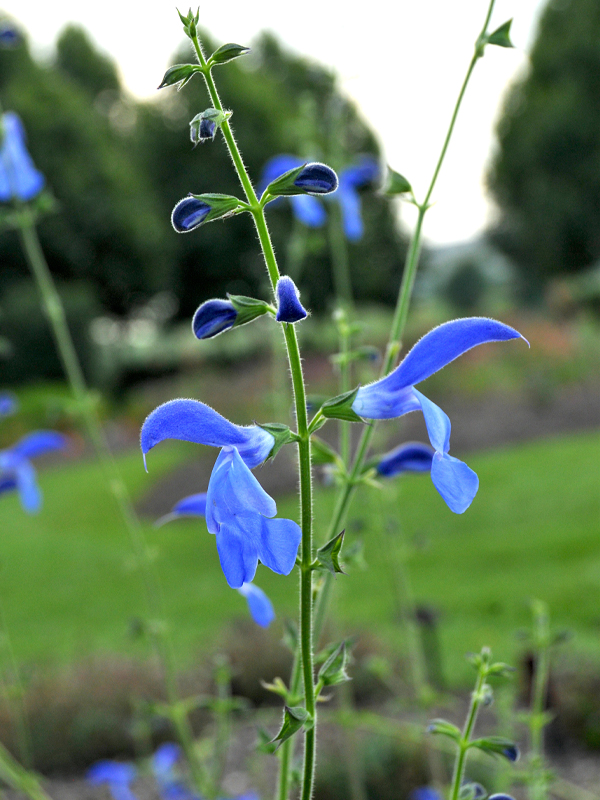
Salvia patens 'Guanajuato'
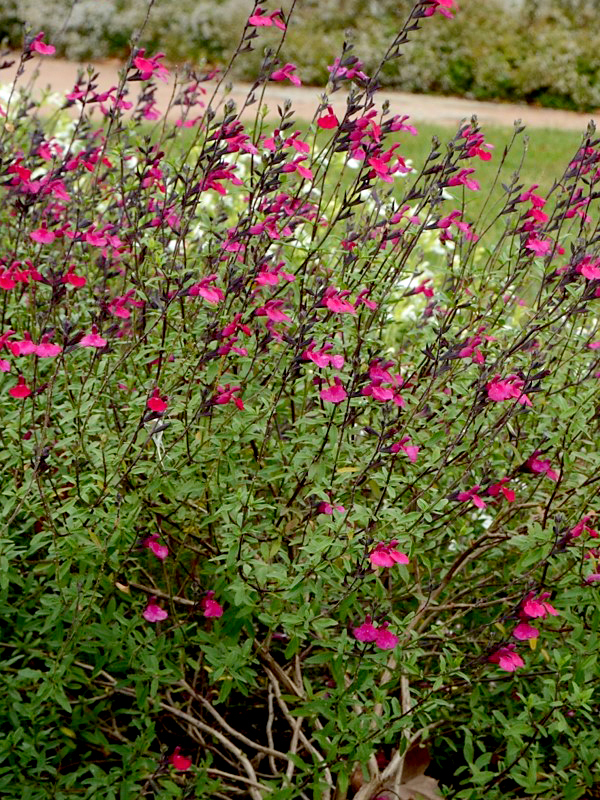
Salvia greggii 'Viva'
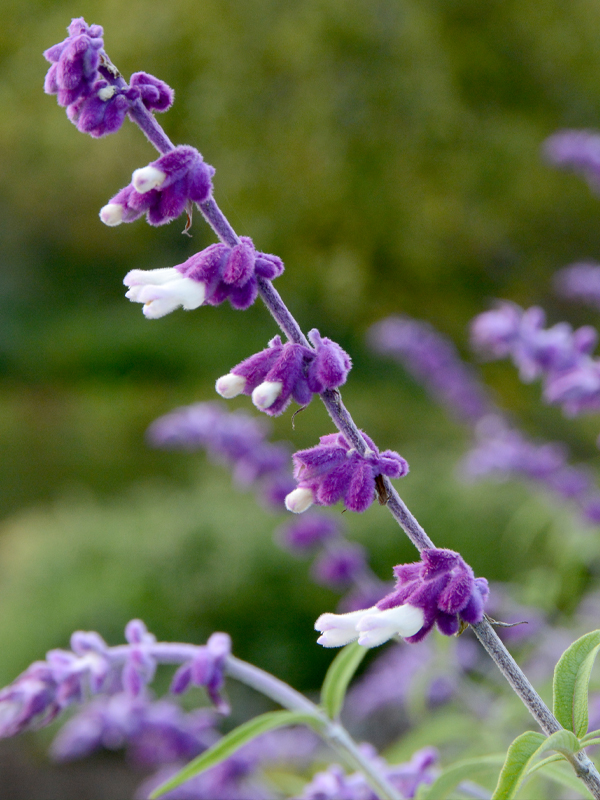
Salvia leucantha
Flowers were borne in spikes held above the foliage; the size and character of the flowers and spikes varied by species and cultivar. Salvia patens ‘Guanajuato’, S. regla ‘Jame’, and S. regla Queretaro form had the largest flowers at 2¼ inches long; whereas, the flowers of S. reptans West Texas form were the smallest at 3/8-inch long. Flower spikes ranged from 5 inches on S. buchananii to 27 inches long on S. sagittata. Other noteworthy inflorescences included S. ‘Wendy’s Wish’ (25 inches), S. microphylla x sagittata ‘Big Swing’ (19 inches), S. confertiflora and S. mexicana ‘Limelight’ (18 inches), S. guaranitica ‘Black and Bloom’ (16 inches), and S. ‘Amistad’, S. ‘Anthony Parker’, and S. involucrata ‘Mulberry Jam’ (11 inches). Individual flowers were arranged in few- to many-flowered verticillasters; additionally, verticillasters were either loosely spaced or crowded along the axis. For example, S. ‘Indigo Spires’ and S. confertiflora displayed crowded verticillasters; whereas, the verticillasters of S. discolor and S. reptans West Texas form were loosely spaced, which created a more open floral display. Inflorescences were vertical or arched, and simple (unbranched) such as S. MYSTIC SPIRES BLUE™ or multibranched like S. sagittata.
Flowering began as early as mid-June and continued up until the first frost date, which varied each year. The historical frost date at the Chicago Botanic Garden is October 15; the frost date was one month later in 2016 and more than a month later in 2017 but close to target in 2018 (see Table 1). A number of salvias did not began blooming until late September or after, which presented a problem given the historic frost date. Among the salvias with foreshortened bloom periods due to frost in one or more years were Salvia ‘Anthony Parker’, S. confertiflora, S. elegans ‘Golden Delicious’, S. glabrescens ‘Momobana’, S. ‘Jean’s Purple Passion’, S. leucantha, S. leucantha ‘Santa Barbara’, S. melissodora, S. mexicana ‘Limelight’, and S. regla cultivars ‘Jame’, Queretaro form, and ‘Royal’.
While the majority of taxa were heavy flowering with exceptional coverage over an extended period, weak flower production due to poor health and/or decreased plant vigor was noted on Salvia greggii ‘Balmirnose’ MIRAGE™ NEON ROSE, S. involucrata ‘Hadspen’, S. involucrata ‘Shelton Herb Farm’, S. microphylla ‘Pink’, S. microphylla ‘San Carlos Festival’, S. microphylla var. neurepia, S. puberula, S. puberula ‘El Butano’, and S. pulchella x involucrata. In the case of S. chionophylla, S. greggii ‘Black Cherry’, and S. glabrescens ‘Momobana’, plants were healthy but simply produced fewer flowers.
Beyond low flower production, an inferior habit was usually the reason for lower ratings; where possible, judgment on habit quality was based on comparisons with exceptional plants of related taxa rather than non-comparable taxa. For example, Salvia greggii cultivars were compared with each other and not judged against S. guaranitica cultivars. Inferior habit quality was characterized by loose crowns, irregular branching, sprawling stems, and/or brittle branches that broke off or lodged. Loose or see-through habits were common among the cultivars of S. greggii, S. microphylla, S. x jamensis, and hybrids such as ‘Bright Eyes’, ‘Dancing Dolls’, and ‘Orchid Glow’. While many taxa in these groups had generally well-rounded forms, loose crowns were noticeable compared to the dense habits of superior selections such as S. greggii ‘Viva’ and S. microphylla ‘La Trinidad Pink’. In many instances, a dense habit was the difference between receiving an excellent rating and a good one. Loose habits were also common on S. buchananii, S. ‘Jean’s Purple Passion’, S. patens ‘Guanajuato’, S. puberula, and S. ‘Silke’s Dream’.
The cultivars of Salvia involucrata—‘Hadspen’, ‘Mulberry Jam’, and ‘Shelton Herb Farm’—were consistently weak-stemmed, which resulted in mostly decumbent stems not caused by brittleness. The stems of S. blepharophylla ‘Painted Lady’, S. leucantha, S. patens, and S. patens ‘Guanajuato’ were easily and regularly damaged in high winds; in most cases the stems snapped cleanly off, but occasionally, broken stems lodged on the ground but remained attached and alive. The low, spreading habit of S. chionophylla—8 inches tall and 66 inches wide—was too sparse and irregular to make a robust display. Some salvias such as S. blepharophylla ‘Painted Lady’ and S. guaranitica have rhizomatous habits in mild climates, but this trait was not observed during the limited one-year growth period of the trial. Salvia reptans is also rhizomatous, but despite living through two winters and three summers, West Texas form had not exhibited this growth trait as of November 2018.
The majority of tender salvias were fully adapted to the in-ground culture of the trial garden; however, some taxa were affected by environmental issues such as sunscald on Salvia elegans ‘Golden Delicious’ and high winds as previously noted. MIRAGE™ NEON ROSE was the only taxon that did not live to the end of a growing season; plants generally lacked vigor, and dwindled and eventually died by mid- to late summer in each year of the trial. No diseases or pests were observed during the trial period. Depending on how low the temperature dropped, the tender salvias reacted in several ways to the first frost—killed outright, wilted but retained leaf color, or were unaffected. In some instances, plants continued to flower despite leaves being lightly frost-damaged. Frost injury assessments for October 13 and October 22, 2018, are detailed in Table 3; comparable damage was noted following frosts in 2016 and 2017.
Winter survival was generally not expected because the species in the trial are native to Central and South America and the southwestern United States. All plants were left in the garden over winter to determine the possibility of cold-hardiness. Three taxa had one or more plants survive the winter of 2016-2017—Salvia microphylla ‘La Trinidad Pink’, S. roemeriana, and S. reptans West Texas form. All plants of S. roemeriana and S. reptans West Texas form also survived the following winter of 2017-2018 but S. microphylla ‘La Trinidad Pink’ did not. However, S. reptans West Texas form was the only one of the surviving salvias to exhibit exceptional vigor in subsequent summers. Reseeding in the trial plots was noted at insignificant levels. Salvia coccinea ‘Brenthurst’ reseeded each year in close proximity to the parent plants; the seedlings were moderately produced and subsequently flowered true-to-name. Salvia greggii seedlings sprouted in the summers of 2017 and 2018, but were culled before flowering and therefore not attributed to any specific cultivar.
Informal monitoring of insects and birds landing and/or feeding on salvias occurred throughout the growing seasons. However, the random and cursory nature of the observations resulted in anecdotal rather than factual information related to pollinators visiting each respective salvia. Among the various pollinators—categorized broadly rather than by specific species—were hummingbirds, bees, butterflies, and hawkmoths. Hummingbirds appeared to have had a slight preference for blue and purple flowers based on frequent observations made each summer. Conversely, bees and butterflies were more catholic in their visitation of flower colors.
Thirteen salvias received five-star excellent ratings for exceptional flower production over an extended period, healthy foliage, vigorous habits, and adaptability to the growing conditions of the trial garden. Based on cumulative evaluation scores, the top-rated plants in alphabetical order were Salvia ‘Amistad’, S. ‘Balsalmisp’ MYSTIC SPIRES BLUE™, S. coccinea ‘Brenthurst’, S. elegans ‘Golden Delicious’, S. greggii ‘Balmircher’ MIRAGE™ CHERRY RED, S. greggii ‘Balmirhopi’ MIRAGE™ HOT PINK, S. greggii ‘Balmirvio’ MIRAGE™ VIOLET, S. greggii ‘Balmirwite’ MIRAGE™ WHITE, S. greggii ‘Viva’, S. ‘Novasalfuc’ ARCTIC BLAZE® FUCHSIA, S. ‘Novasalred’ ARCTIC BLAZE® RED, S. reptans West Texas form, and S. splendens ‘Dancing Flames’. Additionally, 49 salvias received four-star good ratings for their strong performances.

Salvia ‘Amistad’

S. ‘Balsalmisp’ MYSTIC SPIRES BLUE™

Salvia coccinea ‘Brenthurst’
Salvia ‘Amistad’ embodied the best qualities of the tender salvias. From mid-June to frost, a bounty of dark purple blossoms nestled in nearly black calyces were loosely borne on erect inflorescences to 11 inches long. The large swarthy flowers were a constant draw for hummingbirds, bees, and butterflies throughout the season. The robust floral show and vigorous habit were impressive each summer despite plants never being fertilized—it was one of the biggest salvias at 46 inches tall and 64 inches wide. ‘Amistad’—meaning friendship in Spanish—originated in Argentina and is thought to be a hybrid between the showy subtropical species S. guaranitica and S. gesneriiflora.
MYSTIC SPIRES BLUE™ (Salvia ‘Balsalmisp’) featured tall spires of purple-blue flowers in violet calyces from late spring to frost. While the individual flowers were small (¾ inch long), the floral show was significant because the verticillasters were densely clustered on long inflorescences—the prolific floral stems made up about half of the plant height. MYSTIC SPIRES BLUE is a compact, well-branched selection of ‘Indigo Spires’ and reached 37 inches tall and 51 inches wide. Planted side by side in the trial, observations in September and October noted that MYSTIC SPIRES BLUE was busy with butterflies and bees while pollinators largely ignored ‘Indigo Spires’. Pollinator visitation during the earlier season was comparable on both cultivars.
The scarlet sage, Salvia coccinea ‘Brenthurst’, was a consistently strong performer with a full robust habit and heavy floriferous nature. Its coral-pink flowers, held in purple- blushed calyces, featured light pink tubes and broad, darker pink lower lips. The bushy mounded habit, to 38 inches tall and wide, was one of the very best in the trial for uniformity. ‘Brenthurst’ was one of a few salvias that reseeded each year; the seedlings were moderately produced and flowered early and true-to-name. Although perennial in Mexico and South America, S. coccinea is recognizable as a widely cultivated and usually red-flowered garden annual.

Salvia elegans ‘Golden Delicious’
The sweetly pineapple-scented golden yellow leaves and fiery red flowers of Salvia elegans ‘Golden Delicious’ were a bold combination. The vibrant leaves held their color all summer, although minor sunscald was noted at times during the hottest periods. The robust habit was consistently bushy and broadly mounding to 44 inches tall and 57 inches wide. Plants began blooming in early October, and while flower production was heavy, the full floral display was not observed in any year of the trial. Mid-November frost dates in 2016 and 2017 resulted in an admirable display; however, plants never reached peak bloom. The colorful foliage on its own was significantly ornamental to recommend ‘Golden Delicious’ as a foliage plant for seasonal displays.

Salvia greggii MIRAGETM CHERRY RED

Salvia ARCTIC BLAZE® FUCHSIA

Salvia reptans West Texas form
Salvia greggii, autumn sage, was well-represented in the trial by 27 selections in vibrant shades of red, pink, violet, purple, and creamy white. Five cultivars received the highest ratings for consistently superior habits and exceptionally strong flower production, including ‘Viva’ and four cultivars in the MIRAGE™ series—CHERRY RED, HOT PINK, VIOLET, and WHITE. Nestled in burgundy calyces, the dark magenta flowers of ‘Viva’ were the smallest of the autumn sages at ¾-inch long and opened a couple of weeks later in June than other selections; plants were densely mounded to 26 inches tall and 40 inches wide. CHERRY RED featured dark cherry red flowers and a dense compact habit to 20 inches tall and 30 inches wide. The bright pink flowers of HOT PINK were cupped in green calyces with a purple-red cast; it was slightly larger at 25 inches tall and 36 inches wide. VIOLET featured dark purple calyces and violet flowers on low mounded plants to 19 inches tall and 28 inches wide. The creamy white flowers of WHITE had pale green calyces, and like the other cultivars in the series, produced a well-branched bushy habit to 20 inches tall and 42 inches wide. Loose to irregular habits, and in some cases reduced flower production, were the main reasons why S. greggii cultivars received lower ratings.
ARCTIC BLAZE® FUCHSIA (Salvia ‘Novasalfuc’) and ARCTIC BLAZE® RED (S. ‘Novasalred’) were strong-blooming selections featuring exceptional habit uniformity. The deep reddish pink flowers and purplish calyces of FUCHSIA were plentiful from late June to season’s end. Likewise, the orangey red flowers and purple-red calyces of RED were equally long-blooming. Both selections had compact bushy habits with flexible purplish stems; FUCHSIA was the smallest at 21 inches tall and 26 inches wide and RED was slightly larger at 23 inches tall and 31 inches wide. The habit of ARCTIC BLAZE® PURPLE (S. ‘Novasalpur’) was loose and see-through compared to the others but was similarly floriferous.
The pungent grasslike leaves of Salvia reptans West Texas form set it apart from other salvias in the trial. The fine-textured foliage softened the bushy shrublike plants, which reached a stocky 39 inches tall and wide long before a flower ever appeared. The cobalt blue flowers began opening in early August and bloomed prolifically to frost. At less than ½-inch long, its flowers were the smallest in the trial but the floral display was not diminished by the diminutive size. West Texas form was the only salvia that was truly cold-hardy in Chicago; no crown injury or plant loss occurred in the two winters of the trial.

Salvia splendens ‘Dancing Flames’

Salvia ‘Anthony Parker’

Salvia confertiflora
Salvia splendens ‘Dancing Flames’ featured bright yellow-speckled leaves and large dark orange flowers held in prominent red-orange calyces. The upright bushy habit—31 inches tall and wide—was the best of the splendens-group. ‘Dancing Flames’ started flowering in late June but the overall ornamental display—vibrant flowers, boldly variegated foliage, and red stems—was particularly good in the late season. Salvia splendens is native to Brazil and is a popular bedding plant that comes in a variety of flower colors.
Four additional taxa—Salvia ‘Anthony Parker’, S. confertiflora, S. leucantha ‘Santa Barbara’, and S. mexicana ‘Limelight’—received nearly perfect ratings except that they flowered too late in the season to be considered substitutes for summer-blooming annuals in northern gardens. The abridged bloom period aside, their strong habits, showy foliage, and heavy flower production warrant special mention.
The blue-purple flowers of Salvia ‘Anthony Parker’ were cupped in fuzzy dark purple calyces and held on arching inflorescences to 12 inches long. The flowers opened in late September so were susceptible to frost damage before peak bloom occurred. A strong floral display was observed in 2016 and 2017 before first frost injured the plants on November 12 and November 22, respectively. However, an early frost on October 13, 2018, resulted in a much truncated flower show; in fact, the dark purple calyces rather than any open flowers provided all the color prior to frost. ‘Anthony Parker’ was a dense bushy plant to 50 inches tall and 64 inches wide with attractive foliage similar to S. elegans.
Red velvet sage, Salvia confertiflora, was one of the best-looking plants in all years of the trial. Lush corrugated leaves, dark red stems, and a vase-shaped habit gave it an impressive architectural presence in summer. The vibrant orange-red flowers clasped in fuzzy dark red-orange calyces opened in late September—the small flow ers were crowded together on slender velvety red wands rising 18 inches above the dark green foliage. Flower production was heavy but like other late-blooming selections, the full floral display was not observed due to autumn frosts. The large, textured leaves had rusty undersides and an unpleasant odor when crushed. Red velvet salvia was fast-growing and quickly reached 46 inches tall and 33 inches wide—it grows to 10 feet tall where it is native in Brazil.

Salvia leucantha ‘Santa Barbara’

Salvia mexicana ‘Limelight’

Bicolored Salvia microphylla ‘Hot Lips’
Salvia leucantha ‘Santa Barbara’ was a superior selection because its stems were not as brittle as the species, which constantly suffered snapped branches in strong winds. While the color contrast was not as striking as the bright white and fuzzy purple flowers of the species, ‘Santa Barbara’ produced an exceptionally heavy bloom of light purple flowers with fuzzy dark purple calyces from late September to frost. Despite the late start, 80 percent of flowers were typically open at frost including in 2018. The narrow, downy gray-green leaves were attractive all season, which was an important ornamental feature given the late flowering date; the habit was compact by comparison to the species—nearly 20 inches shorter and narrower.
At 57 inches tall and nearly as wide, Salvia mexicana ‘Limelight’ was one of the largest salvias in the trial. Its glossy heart-shaped leaves and imposing vase-shaped habit were lush and bold-textured all summer. Generous spikes of long dark purple-blue flowers offset by bright chartreuse calyces were the crowning touch. Inflorescences were borne in profusion, but flowers did not open until early October, which mattered a great deal in 2018 when frost came early. In the warmer autumns of 2016 and 2017 when frost was delayed, the floral display was exceptional.
The tender salvias displayed a variety of flower colors in shades of blue, lavender, purple, red, magenta, pink, orange, yellow, and creamy white. Selections with distinctive bicolored flowers included Salvia ‘Autumn Moon’, S. ‘Fancy Dancer’, S. greggii ‘Stormy Pink’, S. greggii ‘Teresa’, S. microphylla ‘Hot Lips’, and S. xjamensis ‘Golden Girl’. The flower color of ‘Hot Lips’ was notably unstable—both red and white single- colored flowers were commonly present along with the red-and-white bicolored flowers. The calyx was an important ornamental trait throughout the bloom cycle because it provided color before flowers opened and remained colorful and persistent for a time after the flowers had fallen. Calyx and flower colors were typically contrasting, often dramatically so, such as the white flowers and bright purple calyces of S. leucantha or the purple-black flowers and silvery yellow-green calyces of S. discolor. Conversely, analogously colored calyces and flowers were observed on S. confertiflora (orange-red), S. puberula (pink), and S. regla ‘Royal’ (deep peachy red). Salvia blepharophylla ‘Painted Lady’, S. discolor, S. leucantha, S. leucantha ‘Santa Barbara’, S. miniata, and S. oxyphora featured fuzzy flowers and/or calyces.

Salvia patens 'Guanajuato'

Salvia greggii 'Viva'

Salvia leucantha
Flowers were borne in spikes held above the foliage; the size and character of the flowers and spikes varied by species and cultivar. Salvia patens ‘Guanajuato’, S. regla ‘Jame’, and S. regla Queretaro form had the largest flowers at 2¼ inches long; whereas, the flowers of S. reptans West Texas form were the smallest at 3/8-inch long. Flower spikes ranged from 5 inches on S. buchananii to 27 inches long on S. sagittata. Other noteworthy inflorescences included S. ‘Wendy’s Wish’ (25 inches), S. microphylla x sagittata ‘Big Swing’ (19 inches), S. confertiflora and S. mexicana ‘Limelight’ (18 inches), S. guaranitica ‘Black and Bloom’ (16 inches), and S. ‘Amistad’, S. ‘Anthony Parker’, and S. involucrata ‘Mulberry Jam’ (11 inches). Individual flowers were arranged in few- to many-flowered verticillasters; additionally, verticillasters were either loosely spaced or crowded along the axis. For example, S. ‘Indigo Spires’ and S. confertiflora displayed crowded verticillasters; whereas, the verticillasters of S. discolor and S. reptans West Texas form were loosely spaced, which created a more open floral display. Inflorescences were vertical or arched, and simple (unbranched) such as S. MYSTIC SPIRES BLUE™ or multibranched like S. sagittata.
Flowering began as early as mid-June and continued up until the first frost date, which varied each year. The historical frost date at the Chicago Botanic Garden is October 15; the frost date was one month later in 2016 and more than a month later in 2017 but close to target in 2018 (see Table 1). A number of salvias did not began blooming until late September or after, which presented a problem given the historic frost date. Among the salvias with foreshortened bloom periods due to frost in one or more years were Salvia ‘Anthony Parker’, S. confertiflora, S. elegans ‘Golden Delicious’, S. glabrescens ‘Momobana’, S. ‘Jean’s Purple Passion’, S. leucantha, S. leucantha ‘Santa Barbara’, S. melissodora, S. mexicana ‘Limelight’, and S. regla cultivars ‘Jame’, Queretaro form, and ‘Royal’.
While the majority of taxa were heavy flowering with exceptional coverage over an extended period, weak flower production due to poor health and/or decreased plant vigor was noted on Salvia greggii ‘Balmirnose’ MIRAGE™ NEON ROSE, S. involucrata ‘Hadspen’, S. involucrata ‘Shelton Herb Farm’, S. microphylla ‘Pink’, S. microphylla ‘San Carlos Festival’, S. microphylla var. neurepia, S. puberula, S. puberula ‘El Butano’, and S. pulchella x involucrata. In the case of S. chionophylla, S. greggii ‘Black Cherry’, and S. glabrescens ‘Momobana’, plants were healthy but simply produced fewer flowers.
Beyond low flower production, an inferior habit was usually the reason for lower ratings; where possible, judgment on habit quality was based on comparisons with exceptional plants of related taxa rather than non-comparable taxa. For example, Salvia greggii cultivars were compared with each other and not judged against S. guaranitica cultivars. Inferior habit quality was characterized by loose crowns, irregular branching, sprawling stems, and/or brittle branches that broke off or lodged. Loose or see-through habits were common among the cultivars of S. greggii, S. microphylla, S. x jamensis, and hybrids such as ‘Bright Eyes’, ‘Dancing Dolls’, and ‘Orchid Glow’. While many taxa in these groups had generally well-rounded forms, loose crowns were noticeable compared to the dense habits of superior selections such as S. greggii ‘Viva’ and S. microphylla ‘La Trinidad Pink’. In many instances, a dense habit was the difference between receiving an excellent rating and a good one. Loose habits were also common on S. buchananii, S. ‘Jean’s Purple Passion’, S. patens ‘Guanajuato’, S. puberula, and S. ‘Silke’s Dream’.
The cultivars of Salvia involucrata—‘Hadspen’, ‘Mulberry Jam’, and ‘Shelton Herb Farm’—were consistently weak-stemmed, which resulted in mostly decumbent stems not caused by brittleness. The stems of S. blepharophylla ‘Painted Lady’, S. leucantha, S. patens, and S. patens ‘Guanajuato’ were easily and regularly damaged in high winds; in most cases the stems snapped cleanly off, but occasionally, broken stems lodged on the ground but remained attached and alive. The low, spreading habit of S. chionophylla—8 inches tall and 66 inches wide—was too sparse and irregular to make a robust display. Some salvias such as S. blepharophylla ‘Painted Lady’ and S. guaranitica have rhizomatous habits in mild climates, but this trait was not observed during the limited one-year growth period of the trial. Salvia reptans is also rhizomatous, but despite living through two winters and three summers, West Texas form had not exhibited this growth trait as of November 2018.
The majority of tender salvias were fully adapted to the in-ground culture of the trial garden; however, some taxa were affected by environmental issues such as sunscald on Salvia elegans ‘Golden Delicious’ and high winds as previously noted. MIRAGE™ NEON ROSE was the only taxon that did not live to the end of a growing season; plants generally lacked vigor, and dwindled and eventually died by mid- to late summer in each year of the trial. No diseases or pests were observed during the trial period. Depending on how low the temperature dropped, the tender salvias reacted in several ways to the first frost—killed outright, wilted but retained leaf color, or were unaffected. In some instances, plants continued to flower despite leaves being lightly frost-damaged. Frost injury assessments for October 13 and October 22, 2018, are detailed in Table 3; comparable damage was noted following frosts in 2016 and 2017.
Winter survival was generally not expected because the species in the trial are native to Central and South America and the southwestern United States. All plants were left in the garden over winter to determine the possibility of cold-hardiness. Three taxa had one or more plants survive the winter of 2016-2017—Salvia microphylla ‘La Trinidad Pink’, S. roemeriana, and S. reptans West Texas form. All plants of S. roemeriana and S. reptans West Texas form also survived the following winter of 2017-2018 but S. microphylla ‘La Trinidad Pink’ did not. However, S. reptans West Texas form was the only one of the surviving salvias to exhibit exceptional vigor in subsequent summers. Reseeding in the trial plots was noted at insignificant levels. Salvia coccinea ‘Brenthurst’ reseeded each year in close proximity to the parent plants; the seedlings were moderately produced and subsequently flowered true-to-name. Salvia greggii seedlings sprouted in the summers of 2017 and 2018, but were culled before flowering and therefore not attributed to any specific cultivar.
Informal monitoring of insects and birds landing and/or feeding on salvias occurred throughout the growing seasons. However, the random and cursory nature of the observations resulted in anecdotal rather than factual information related to pollinators visiting each respective salvia. Among the various pollinators—categorized broadly rather than by specific species—were hummingbirds, bees, butterflies, and hawkmoths. Hummingbirds appeared to have had a slight preference for blue and purple flowers based on frequent observations made each summer. Conversely, bees and butterflies were more catholic in their visitation of flower colors.
-
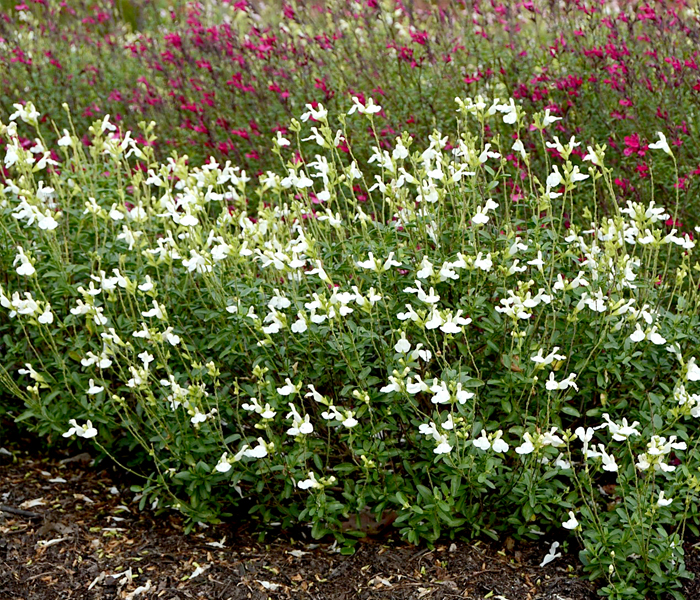
Salvia greggii MIRAGETM WHITE
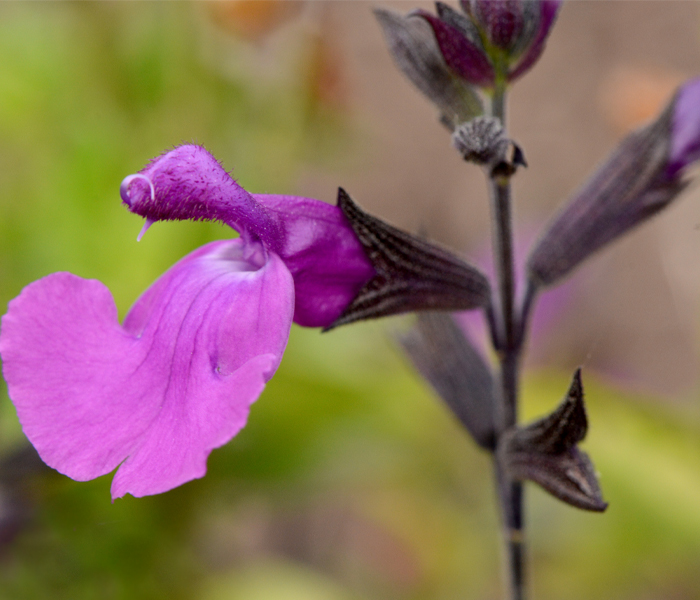
Salvia greggii MIRAGETM VIOLET
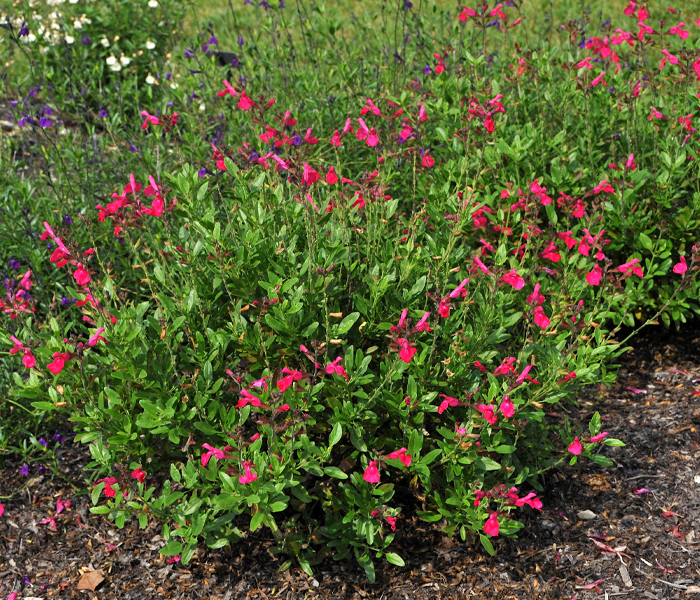
Salvia greggii MIRAGETM HOT PINK
Upon completion of the three-year study, a variety of tender salvias—representing the diversity within the group—are highly recommended as summer annuals for garden beds and containers. The top-rated salvias offer a myriad of flower colors, attractive foliage, and small to large plant sizes. The thirteen salvias that received five-star excellent ratings included Salvia ‘Amistad’, S. ‘Balsalmisp’ MYSTIC SPIRES BLUE™, S. coccinea ‘Brenthurst’, S. elegans ‘Golden Delicious’, S. greggii ‘Balmircher’ MIRAGE ™ CHERRY RED, S. greggii ‘Balmirhopi’ MIRAGE™ HOT PINK, S. greggii ‘Balmirvio’ MIRAGE™ VIOLET, S. greggii ‘Balmirwite’ MIRAGE™ WHITE, S. greggii ‘Viva’, S. ‘Novasalfuc’ ARCTIC BLAZE® FUCHSIA, S. ‘Novasalred’ ARCTIC BLAZE® RED, S. reptans West Texas form, and S. splendens ‘Dancing Flames’. Forty- nine other salvias received four-star good ratings for their strong performances.
Most tender salvias bloomed freely and for an extended period, often beginning in mid-June and blooming continually until frost in October or November. A number of salvias that bloomed late in the season— from September onward—experienced shortened bloom periods because of frost injury. Although many of the late-flowering salvias displayed outstanding ornamental traits and plant vigor, they are not recommended as summer annuals for average gardens in colder zones. Among the exceptional late-blooming taxa were Salvia ‘Anthony Parker’, S. confertiflora, S. leucantha ‘Santa Barbara’, and S. mexicana ‘Limelight’. All of these salvias were attractive and robust during the summer and produced an abundance of flower buds, which provided a good, albeit short floral show before frost.

Salvia ARCTIC BLAZE® RED
The majority of the salvias proved to be well-adapted to the soils and growing conditions of the trial garden, although other environmental challenges of the site such as full sun and strong winds were noted. The golden yellow leaves of Salvia elegans ‘Golden Delicious’ were occasionally sunburned during hot weather; it is probably best suited for partial or afternoon shade to keep foliage healthy and vibrant. Brittle- stemmed salvias such as S. blepharophylla ‘Painted Lady’, S. leucantha, and S. patens ‘Guanajuato’ would do better sheltered in sunny locations out of strong wind.
The effects of fertilizing and deadheading on plant size and flowering performance was indeterminate due to the minimal maintenance practices followed in the trial garden. In comparing the performance of ‘Indigo Spires’, ‘Black and Blue’, ‘Black and Bloom, and ‘Amistad’ to these same salvias growing in other local gardens where plants are fertilized, it can be concluded that regular fertilization may significantly increase plant size and vigor. The heavy flower production and sustained bloom observed over a protracted period suggests that deadheading is generally unnecessary to promote re-bloom. In fact, the strong showing of so many tender salvias indicates that limiting garden care to regular watering only is sufficient in most cases to ensure healthy, floriferous plants.
Tender salvias are exceptional garden plants with vibrant and multi-hued flowers, bold habits, and handsome foliage, and are easy-care, versatile, and pollinator-friendly. The hundreds of varieties available at local garden centers and by mail order gives gardeners a multitude of choices. Many tender salvias can be counted on for a long season of colorful and bountiful flowers in summer gardens and seasonal pots.

Salvia greggii MIRAGETM WHITE

Salvia greggii MIRAGETM VIOLET

Salvia greggii MIRAGETM HOT PINK
Upon completion of the three-year study, a variety of tender salvias—representing the diversity within the group—are highly recommended as summer annuals for garden beds and containers. The top-rated salvias offer a myriad of flower colors, attractive foliage, and small to large plant sizes. The thirteen salvias that received five-star excellent ratings included Salvia ‘Amistad’, S. ‘Balsalmisp’ MYSTIC SPIRES BLUE™, S. coccinea ‘Brenthurst’, S. elegans ‘Golden Delicious’, S. greggii ‘Balmircher’ MIRAGE ™ CHERRY RED, S. greggii ‘Balmirhopi’ MIRAGE™ HOT PINK, S. greggii ‘Balmirvio’ MIRAGE™ VIOLET, S. greggii ‘Balmirwite’ MIRAGE™ WHITE, S. greggii ‘Viva’, S. ‘Novasalfuc’ ARCTIC BLAZE® FUCHSIA, S. ‘Novasalred’ ARCTIC BLAZE® RED, S. reptans West Texas form, and S. splendens ‘Dancing Flames’. Forty- nine other salvias received four-star good ratings for their strong performances.
Most tender salvias bloomed freely and for an extended period, often beginning in mid-June and blooming continually until frost in October or November. A number of salvias that bloomed late in the season— from September onward—experienced shortened bloom periods because of frost injury. Although many of the late-flowering salvias displayed outstanding ornamental traits and plant vigor, they are not recommended as summer annuals for average gardens in colder zones. Among the exceptional late-blooming taxa were Salvia ‘Anthony Parker’, S. confertiflora, S. leucantha ‘Santa Barbara’, and S. mexicana ‘Limelight’. All of these salvias were attractive and robust during the summer and produced an abundance of flower buds, which provided a good, albeit short floral show before frost.

Salvia ARCTIC BLAZE® RED
The majority of the salvias proved to be well-adapted to the soils and growing conditions of the trial garden, although other environmental challenges of the site such as full sun and strong winds were noted. The golden yellow leaves of Salvia elegans ‘Golden Delicious’ were occasionally sunburned during hot weather; it is probably best suited for partial or afternoon shade to keep foliage healthy and vibrant. Brittle- stemmed salvias such as S. blepharophylla ‘Painted Lady’, S. leucantha, and S. patens ‘Guanajuato’ would do better sheltered in sunny locations out of strong wind.
The effects of fertilizing and deadheading on plant size and flowering performance was indeterminate due to the minimal maintenance practices followed in the trial garden. In comparing the performance of ‘Indigo Spires’, ‘Black and Blue’, ‘Black and Bloom, and ‘Amistad’ to these same salvias growing in other local gardens where plants are fertilized, it can be concluded that regular fertilization may significantly increase plant size and vigor. The heavy flower production and sustained bloom observed over a protracted period suggests that deadheading is generally unnecessary to promote re-bloom. In fact, the strong showing of so many tender salvias indicates that limiting garden care to regular watering only is sufficient in most cases to ensure healthy, floriferous plants.
Tender salvias are exceptional garden plants with vibrant and multi-hued flowers, bold habits, and handsome foliage, and are easy-care, versatile, and pollinator-friendly. The hundreds of varieties available at local garden centers and by mail order gives gardeners a multitude of choices. Many tender salvias can be counted on for a long season of colorful and bountiful flowers in summer gardens and seasonal pots.

